Home » Wind Turbine
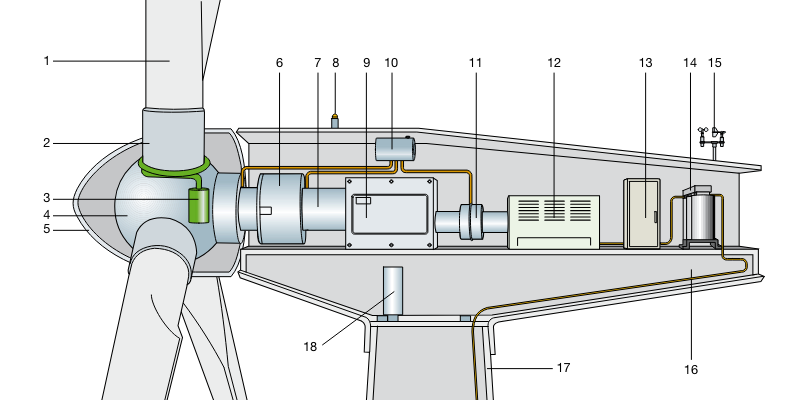 To exploit the kinetic energy of the wind, by converting it into electrical energy available to be fed into the network or to supply loads in parallel, a wind turbine uses different components both mechanical as well as electrical. In particular, the rotor (blades and hub) extracts energy from the wind turning it into mechanical rotation energy and constitutes the “first motor” of the wind turbine, whereas conversion of mechanical energy into electrical energy is carried out by an electric generator according to suitable configurations.
To exploit the kinetic energy of the wind, by converting it into electrical energy available to be fed into the network or to supply loads in parallel, a wind turbine uses different components both mechanical as well as electrical. In particular, the rotor (blades and hub) extracts energy from the wind turning it into mechanical rotation energy and constitutes the “first motor” of the wind turbine, whereas conversion of mechanical energy into electrical energy is carried out by an electric generator according to suitable configurations.
Due to their principle of operation, wind turbines have to be set up outdoors and are used in a wide range of climatic environments. 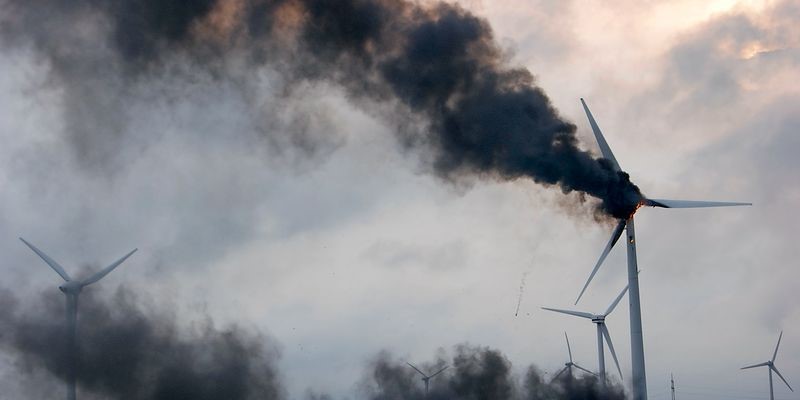 Wind power plants, being installed outdoor, may be subject to direct and indirect overvoltages of atmospheric origin, besides being subject to switching overvoltages. Lightning protection allows risks for people (mainly the personnel in charge) and maintenance operations due to damages on structure and on the internal components to be reduced and measures against economical losses because of drop of energy production due to the plant failure to be taken.
Wind power plants, being installed outdoor, may be subject to direct and indirect overvoltages of atmospheric origin, besides being subject to switching overvoltages. Lightning protection allows risks for people (mainly the personnel in charge) and maintenance operations due to damages on structure and on the internal components to be reduced and measures against economical losses because of drop of energy production due to the plant failure to be taken.
 Wind power plants, being installed outdoor, may be subject to direct and indirect overvoltages of atmospheric origin, besides being subject to switching overvoltages. Lightning protection allows risks for people (mainly the personnel in charge) and maintenance operations due to damages on structure and on the internal components to be reduced and measures against economical losses because of drop of energy production due to the plant failure to be taken.
Wind power plants, being installed outdoor, may be subject to direct and indirect overvoltages of atmospheric origin, besides being subject to switching overvoltages. Lightning protection allows risks for people (mainly the personnel in charge) and maintenance operations due to damages on structure and on the internal components to be reduced and measures against economical losses because of drop of energy production due to the plant failure to be taken.
A wind turbine is a rotating machine which converts the kinetic energy in wind into mechanical energy.
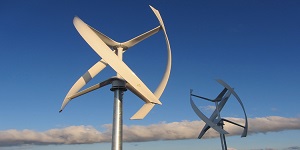
If the mechanical energy is then converted to electricity, the machine is called a wind generator, wind turbine, wind power unit (WPU), wind energy converter (WEC), or aerogenerator. Wind turbines can be separated into two types based by the axis in which the turbine rotates. Turbines that rotate around a horizontal axis are more common. Vertical-axis turbines are less frequently used. Horizontal-axis wind turbines (HAWT) have the main rotor shaft and electrical generator at the top of a tower, and must be pointed into the wind.
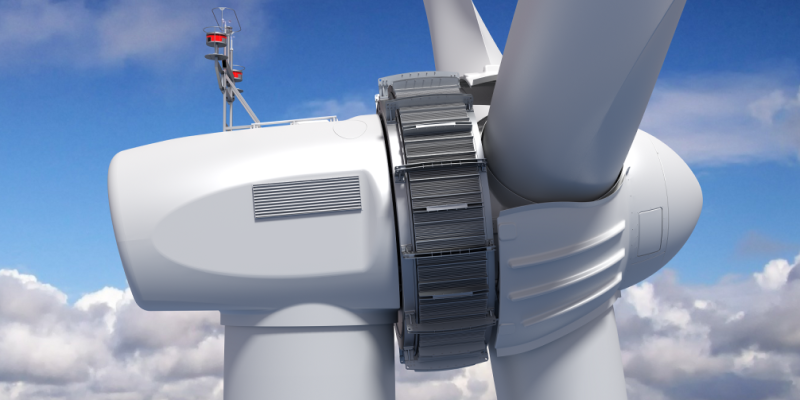
Wind turbine technology has been developed by continuously optimizing turbine design, improving turbine performance, and enhancing overall turbine efficiency. There have been several generations of development and improvement in wind turbine technology, concentrated on blades, generators, direct drive techniques, pitch and yaw control systems, and so on. The current major trends in the development of wind turbines are towards higher power, higher efficiency and reliability, and lower cost per kilowatt machines.
Wind turbine control systems continue to play important roles for ensuring wind turbine reliable and safe operation and to optimize wind energy capture. 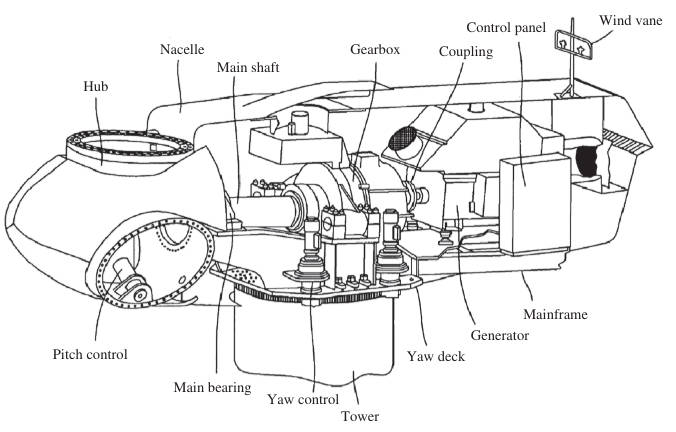 The main control systems in a modern wind turbine include pitch control, stall control (passive and active), yaw control, and others. Under high wind speed conditions, the power output from a wind turbine may exceed its rated value. Thus, power control is required to control the power output within allowable fluctuations for avoiding turbine damage and stabilizing the power output. There are two primary control strategies in the power control: pitch control and stall control. The wind turbine power control system is used to control the power output within allowable fluctuations.
The main control systems in a modern wind turbine include pitch control, stall control (passive and active), yaw control, and others. Under high wind speed conditions, the power output from a wind turbine may exceed its rated value. Thus, power control is required to control the power output within allowable fluctuations for avoiding turbine damage and stabilizing the power output. There are two primary control strategies in the power control: pitch control and stall control. The wind turbine power control system is used to control the power output within allowable fluctuations.
 The main control systems in a modern wind turbine include pitch control, stall control (passive and active), yaw control, and others. Under high wind speed conditions, the power output from a wind turbine may exceed its rated value. Thus, power control is required to control the power output within allowable fluctuations for avoiding turbine damage and stabilizing the power output. There are two primary control strategies in the power control: pitch control and stall control. The wind turbine power control system is used to control the power output within allowable fluctuations.
The main control systems in a modern wind turbine include pitch control, stall control (passive and active), yaw control, and others. Under high wind speed conditions, the power output from a wind turbine may exceed its rated value. Thus, power control is required to control the power output within allowable fluctuations for avoiding turbine damage and stabilizing the power output. There are two primary control strategies in the power control: pitch control and stall control. The wind turbine power control system is used to control the power output within allowable fluctuations.
According to the drivetrain condition in a wind generator system, wind turbines can be classified as either direct drive or geared drive groups. 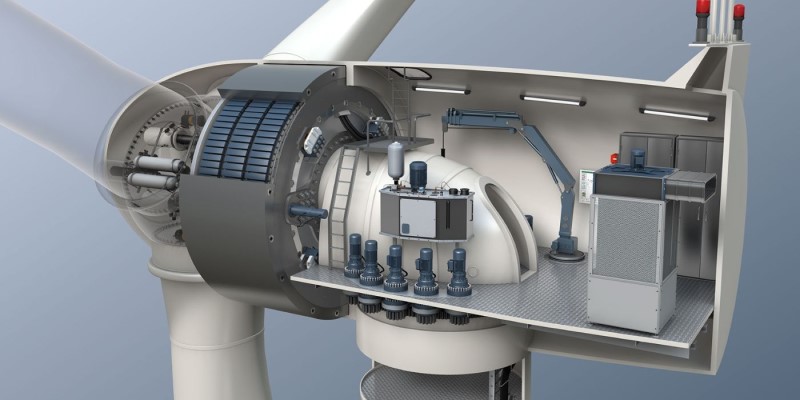 To increase the generator rotor rotating speed to gain a higher power output, a regular geared drive wind turbine typically uses a multi-stage gearbox to take the rotational speed from the low-speed shaft of the blade rotor and transform it into a fast rotation on the high-speed shaft of the generator rotor. The advantages of geared generator systems include lower cost and smaller size and weight. However, utilization of a gearbox can significantly lower wind turbine reliability and increase turbine noise level and mechanical losses.
To increase the generator rotor rotating speed to gain a higher power output, a regular geared drive wind turbine typically uses a multi-stage gearbox to take the rotational speed from the low-speed shaft of the blade rotor and transform it into a fast rotation on the high-speed shaft of the generator rotor. The advantages of geared generator systems include lower cost and smaller size and weight. However, utilization of a gearbox can significantly lower wind turbine reliability and increase turbine noise level and mechanical losses.
 To increase the generator rotor rotating speed to gain a higher power output, a regular geared drive wind turbine typically uses a multi-stage gearbox to take the rotational speed from the low-speed shaft of the blade rotor and transform it into a fast rotation on the high-speed shaft of the generator rotor. The advantages of geared generator systems include lower cost and smaller size and weight. However, utilization of a gearbox can significantly lower wind turbine reliability and increase turbine noise level and mechanical losses.
To increase the generator rotor rotating speed to gain a higher power output, a regular geared drive wind turbine typically uses a multi-stage gearbox to take the rotational speed from the low-speed shaft of the blade rotor and transform it into a fast rotation on the high-speed shaft of the generator rotor. The advantages of geared generator systems include lower cost and smaller size and weight. However, utilization of a gearbox can significantly lower wind turbine reliability and increase turbine noise level and mechanical losses.
Besides the obvious advantages of renewable energy, such as zero greenhouse gases (GHG) emissions and low operational costs, 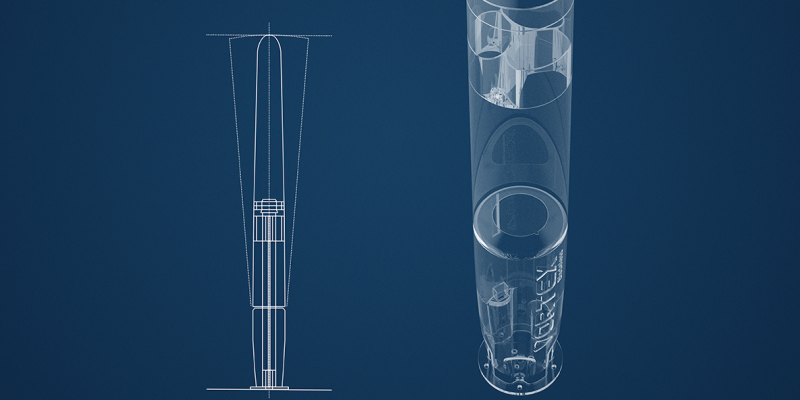 solar panels and wind turbines also have their own drawbacks. The use of solar panels raises enormous questions about expired solar cells, while wind turbines have been considered unsuitable for urban areas. Harnessing wind power in urban areas requires overcoming the disadvantages of vibration and noise as well as challenges related to the space of installation. Bladeless wind turbines (BWT) are an advanced technology that converts wind energy to electrical energy in cities.
solar panels and wind turbines also have their own drawbacks. The use of solar panels raises enormous questions about expired solar cells, while wind turbines have been considered unsuitable for urban areas. Harnessing wind power in urban areas requires overcoming the disadvantages of vibration and noise as well as challenges related to the space of installation. Bladeless wind turbines (BWT) are an advanced technology that converts wind energy to electrical energy in cities.
 solar panels and wind turbines also have their own drawbacks. The use of solar panels raises enormous questions about expired solar cells, while wind turbines have been considered unsuitable for urban areas. Harnessing wind power in urban areas requires overcoming the disadvantages of vibration and noise as well as challenges related to the space of installation. Bladeless wind turbines (BWT) are an advanced technology that converts wind energy to electrical energy in cities.
solar panels and wind turbines also have their own drawbacks. The use of solar panels raises enormous questions about expired solar cells, while wind turbines have been considered unsuitable for urban areas. Harnessing wind power in urban areas requires overcoming the disadvantages of vibration and noise as well as challenges related to the space of installation. Bladeless wind turbines (BWT) are an advanced technology that converts wind energy to electrical energy in cities.
Wind energy is the kinetic energy that is present in moving air. The amount of potential energy depends mainly on wind speed, but is also affected slightly by the density of the air,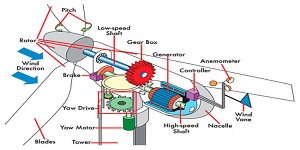 which is determined by the air temperature, barometric pressure and altitude. For any wind turbine, the power and energy output increases dramatically as the wind speed increases. Therefore, the most cost-effective wind turbines are located in the windiest areas. Wind speed is affected by the local terrain and increases with height above the ground, so wind turbines are usually mounted on tall towers.
which is determined by the air temperature, barometric pressure and altitude. For any wind turbine, the power and energy output increases dramatically as the wind speed increases. Therefore, the most cost-effective wind turbines are located in the windiest areas. Wind speed is affected by the local terrain and increases with height above the ground, so wind turbines are usually mounted on tall towers.
 which is determined by the air temperature, barometric pressure and altitude. For any wind turbine, the power and energy output increases dramatically as the wind speed increases. Therefore, the most cost-effective wind turbines are located in the windiest areas. Wind speed is affected by the local terrain and increases with height above the ground, so wind turbines are usually mounted on tall towers.
which is determined by the air temperature, barometric pressure and altitude. For any wind turbine, the power and energy output increases dramatically as the wind speed increases. Therefore, the most cost-effective wind turbines are located in the windiest areas. Wind speed is affected by the local terrain and increases with height above the ground, so wind turbines are usually mounted on tall towers.
Today, the most common design of wind turbine is the horizontal axis wind turbine (HAWT). 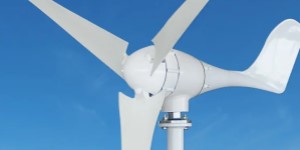 That is, the axis of rotation is parallel to the ground. HAWT rotors are usually classified according to the rotor orientation (upwind or downwind of the tower), hub design (rigid or teetering), rotor control (pitch vs. stall), number of blades (usually two or three blades), and how they are aligned with the wind (free yaw or active yaw).
That is, the axis of rotation is parallel to the ground. HAWT rotors are usually classified according to the rotor orientation (upwind or downwind of the tower), hub design (rigid or teetering), rotor control (pitch vs. stall), number of blades (usually two or three blades), and how they are aligned with the wind (free yaw or active yaw).
A short introduction to and overview of some of the most important components follows.
 That is, the axis of rotation is parallel to the ground. HAWT rotors are usually classified according to the rotor orientation (upwind or downwind of the tower), hub design (rigid or teetering), rotor control (pitch vs. stall), number of blades (usually two or three blades), and how they are aligned with the wind (free yaw or active yaw).
That is, the axis of rotation is parallel to the ground. HAWT rotors are usually classified according to the rotor orientation (upwind or downwind of the tower), hub design (rigid or teetering), rotor control (pitch vs. stall), number of blades (usually two or three blades), and how they are aligned with the wind (free yaw or active yaw). A short introduction to and overview of some of the most important components follows.
Wind turbines are machines that generate electricity from the kinetic energy of the wind. 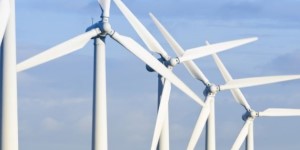 In history, they were more frequently used as a mechanical device that turned machinery. Today, turbines can be used to generate large amounts of electrical energy in wind farms both onshore and offshore.
In history, they were more frequently used as a mechanical device that turned machinery. Today, turbines can be used to generate large amounts of electrical energy in wind farms both onshore and offshore.
There are two kinds of wind turbine, namely the Horizontal Axis Wind Turbine (HAWT) and the Vertical Axis Wind Turbine (VAWT). Before acquiring a home wind turbine, we need to understand which type is more suitable to avoid additional financial losses.
 In history, they were more frequently used as a mechanical device that turned machinery. Today, turbines can be used to generate large amounts of electrical energy in wind farms both onshore and offshore.
In history, they were more frequently used as a mechanical device that turned machinery. Today, turbines can be used to generate large amounts of electrical energy in wind farms both onshore and offshore.There are two kinds of wind turbine, namely the Horizontal Axis Wind Turbine (HAWT) and the Vertical Axis Wind Turbine (VAWT). Before acquiring a home wind turbine, we need to understand which type is more suitable to avoid additional financial losses.
Wind energy conversion systems can be divided into those that depend on aerodynamic drag and those that depend on aerodynamic lift. The early Persian (or Chinese) vertical axis wind wheels utilised the drag principle. 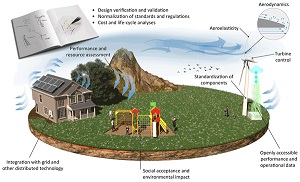 Drag devises, however, have a very low power coefficient, with a maximum of around 0.16. Modern wind turbines are based predominately on aerodynamic lift. Lift devices use airfoils (blades) that interact with the incoming wind. The force resulting from the airfoil body intercepting the airflow consists not only of a drag force component in the direction of the flow but also of a force component that is perpendicular to the drag: the lift forces. The lift force is a multiple of the drag force and therefore the relevant driving power of the rotor. By definition, it is perpendicular to the direction of the air flow that is intercepted by the rotor blade and, via the leverage of the rotor, it causes the necessary driving torque.
Drag devises, however, have a very low power coefficient, with a maximum of around 0.16. Modern wind turbines are based predominately on aerodynamic lift. Lift devices use airfoils (blades) that interact with the incoming wind. The force resulting from the airfoil body intercepting the airflow consists not only of a drag force component in the direction of the flow but also of a force component that is perpendicular to the drag: the lift forces. The lift force is a multiple of the drag force and therefore the relevant driving power of the rotor. By definition, it is perpendicular to the direction of the air flow that is intercepted by the rotor blade and, via the leverage of the rotor, it causes the necessary driving torque.
 Drag devises, however, have a very low power coefficient, with a maximum of around 0.16. Modern wind turbines are based predominately on aerodynamic lift. Lift devices use airfoils (blades) that interact with the incoming wind. The force resulting from the airfoil body intercepting the airflow consists not only of a drag force component in the direction of the flow but also of a force component that is perpendicular to the drag: the lift forces. The lift force is a multiple of the drag force and therefore the relevant driving power of the rotor. By definition, it is perpendicular to the direction of the air flow that is intercepted by the rotor blade and, via the leverage of the rotor, it causes the necessary driving torque.
Drag devises, however, have a very low power coefficient, with a maximum of around 0.16. Modern wind turbines are based predominately on aerodynamic lift. Lift devices use airfoils (blades) that interact with the incoming wind. The force resulting from the airfoil body intercepting the airflow consists not only of a drag force component in the direction of the flow but also of a force component that is perpendicular to the drag: the lift forces. The lift force is a multiple of the drag force and therefore the relevant driving power of the rotor. By definition, it is perpendicular to the direction of the air flow that is intercepted by the rotor blade and, via the leverage of the rotor, it causes the necessary driving torque.
Basic parts of home wind energy systems generally comprise a rotor, a generator or alternator mounted on a frame, 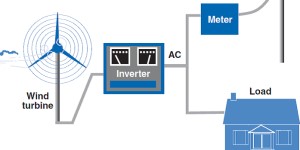 a tail (usually), a tower, wiring, and the "balance of system" components: controllers, inverters, and/or batteries. Through the spinning blades, the rotor captures the kinetic energy of the wind and converts it into rotary motion to drive the generator, which produces either AC or wild AC (variable frequency, variable voltage), which is typically converted to grid-compatible AC electricity.
a tail (usually), a tower, wiring, and the "balance of system" components: controllers, inverters, and/or batteries. Through the spinning blades, the rotor captures the kinetic energy of the wind and converts it into rotary motion to drive the generator, which produces either AC or wild AC (variable frequency, variable voltage), which is typically converted to grid-compatible AC electricity.
 a tail (usually), a tower, wiring, and the "balance of system" components: controllers, inverters, and/or batteries. Through the spinning blades, the rotor captures the kinetic energy of the wind and converts it into rotary motion to drive the generator, which produces either AC or wild AC (variable frequency, variable voltage), which is typically converted to grid-compatible AC electricity.
a tail (usually), a tower, wiring, and the "balance of system" components: controllers, inverters, and/or batteries. Through the spinning blades, the rotor captures the kinetic energy of the wind and converts it into rotary motion to drive the generator, which produces either AC or wild AC (variable frequency, variable voltage), which is typically converted to grid-compatible AC electricity.
Featured Articles
Overvoltage Protection for Wind ...
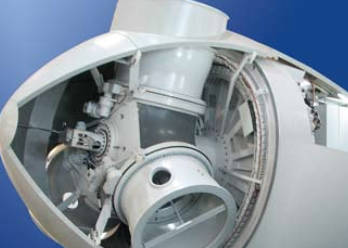 Due to their principle of operation, wind turbines have to be set up outdoors and are used in a wide range of ...
Due to their principle of operation, wind turbines have to be set up outdoors and are used in a wide range of ...
 Due to their principle of operation, wind turbines have to be set up outdoors and are used in a wide range of ...
Due to their principle of operation, wind turbines have to be set up outdoors and are used in a wide range of ...Wind Turbine Glossary
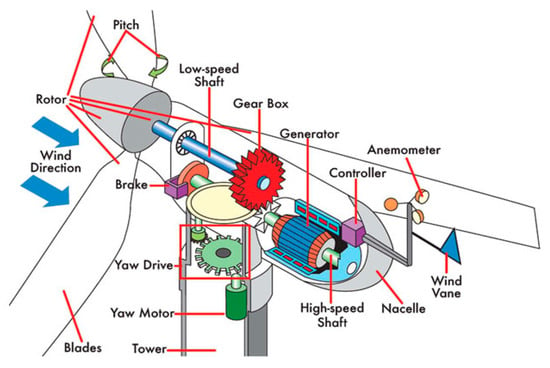 Wind energy is the kinetic energy that is present in moving air. The amount of potential energy depends mainly on wind speed, but ...
Wind energy is the kinetic energy that is present in moving air. The amount of potential energy depends mainly on wind speed, but ...
 Wind energy is the kinetic energy that is present in moving air. The amount of potential energy depends mainly on wind speed, but ...
Wind energy is the kinetic energy that is present in moving air. The amount of potential energy depends mainly on wind speed, but ...Horizontal Axis Wind Turbine Design
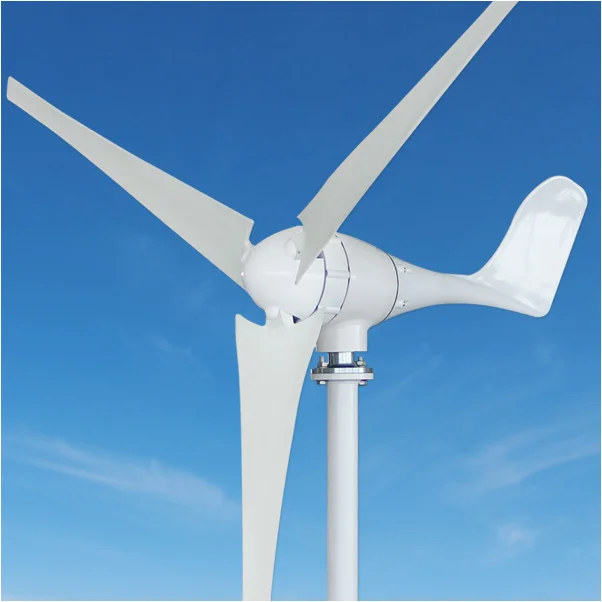 Today, the most common design of wind turbine is the horizontal axis wind turbine (HAWT). That is, the axis of rotation is ...
Today, the most common design of wind turbine is the horizontal axis wind turbine (HAWT). That is, the axis of rotation is ...
 Today, the most common design of wind turbine is the horizontal axis wind turbine (HAWT). That is, the axis of rotation is ...
Today, the most common design of wind turbine is the horizontal axis wind turbine (HAWT). That is, the axis of rotation is ...Horizontal Axis vs. Vertical Axis
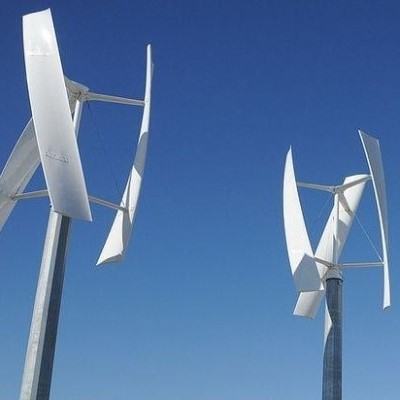 Wind turbines are machines that generate electricity from the kinetic energy of the wind. In history, they were more ...
Wind turbines are machines that generate electricity from the kinetic energy of the wind. In history, they were more ...
 Wind turbines are machines that generate electricity from the kinetic energy of the wind. In history, they were more ...
Wind turbines are machines that generate electricity from the kinetic energy of the wind. In history, they were more ...Household Wind Energy System Components
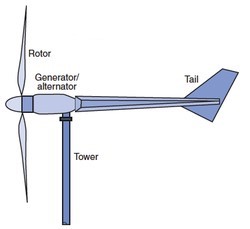 Basic parts of home wind energy systems generally comprise a rotor, a generator or alternator mounted on a frame, a tail ...
Basic parts of home wind energy systems generally comprise a rotor, a generator or alternator mounted on a frame, a tail ...
 Basic parts of home wind energy systems generally comprise a rotor, a generator or alternator mounted on a frame, a tail ...
Basic parts of home wind energy systems generally comprise a rotor, a generator or alternator mounted on a frame, a tail ...